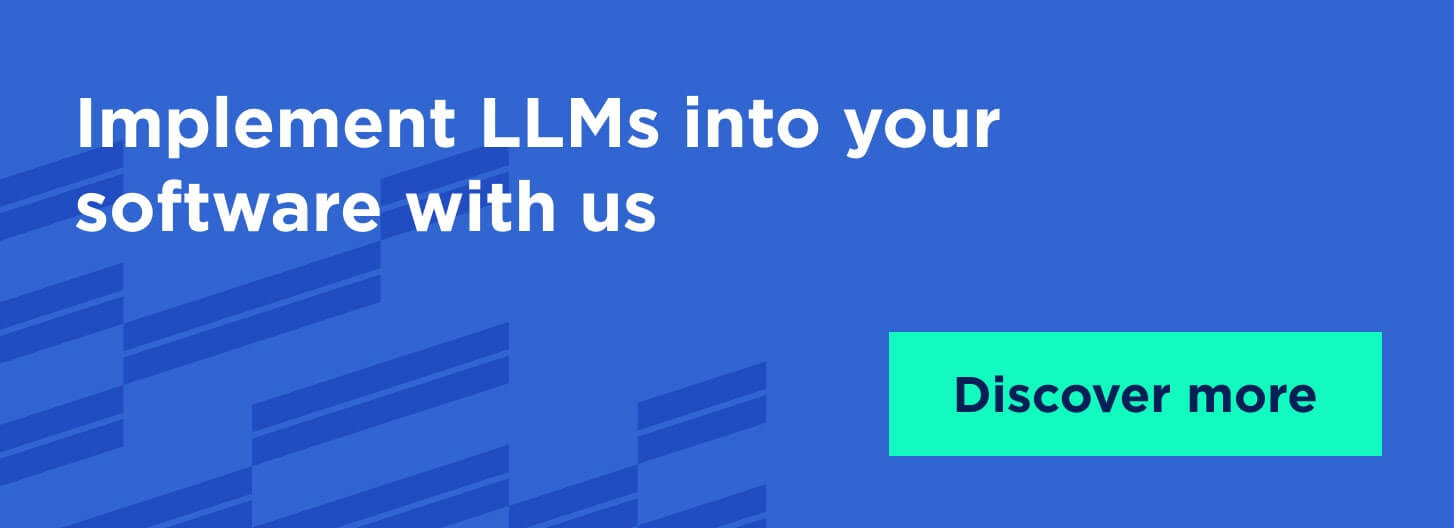Boosting employee productivity, increasing customer engagement with the company and its products/services, and establishing fast and accurate customer support — if you are looking for all these, you should consider large language models. LLMs are one of the generative AI technologies that specialize in textual data processing and generation. You can automate your documentation, administrative tasks, and many more with LLMs.
In this article, we describe the benefits, top large language models examples, and industry applications, along with challenges and steps for successful LLM implementation. Have a good read!
What is an LLM model?
Large language models (LLMs) are based on a transformer framework that allows them to understand textual context and evolve via self-learning. LLMs are effective in generating high-quality textual outputs.
Relying on data indexing, LLMs enhance document processing and analysis and optimize data search. These models can comprehend complicated sentence structures and correctly interpret user intent. LLMs analyze context, semantics, and syntax to ensure maximum output accuracy. The models achieve high levels of personalization, enhancing customer experience by providing the most relevant results to user queries. LLMs improve their accuracy when new data is implemented. This way, the models always provide accurate output due to continuous learning.

Key benefits of large language models
LLMs are getting recognized within businesses, and the market is expected to grow to $105,545 million by 2030 in the North America region. Additionally, experts believe that by 2025, 750 million apps will leverage LLMs and half of digital tasks will be automated thanks to LLMs.

Delegation of routine tasks to LLMs
The delegation of routine tasks to LLMs has emerged as a significant advantage for companies, particularly in terms of accurate information retrieval. Employees daily perform tasks connected with data analysis, which decreases their productivity. Using LLMs, they can devote more time to valuable tasks and hand over data analytics to AI.
To ensure the model works as intended, businesses need to train it with custom data and integrate it with operational datasets. This way, the model will receive the necessary context, enabling employees to extract needed information quickly.
Improved data processing capabilities
LLMs succeed in information processing even with large datasets. Whether analyzing customer feedback, creating responses to customer requests, or extracting needed information from vast reports, LLMs showcase the highest accuracy and speed.
As a result, companies receive a tool that helps them make data-driven decisions.
Automation of content generation
LLMs can autonomously generate high-quality content, including product descriptions, legal documents, and financial reports. This saves businesses time and resources and ensures consistency and accuracy across all communication channels.
Enhanced interactions with customers
LLMs enhance customer experiences by providing personalized recommendations, answering queries in real time, and delivering tailored content based on user's individual preferences and behavior patterns. This level of customization fosters customer loyalty and satisfaction, ultimately driving business growth and profitability.
The integration of LLMs optimizes standard processes, enhances customer experience, and boosts innovation. The models can support businesses by working with large datasets and allowing them to focus on more valuable tasks.
9 top large language model use cases
LLMs can be a powerful tool for businesses working with vast amount of data and seeking new ways to get on top of the market. Read about LLM examples that will make your solution flexible and innovative. Find nine large language models use cases below:

1. Chatbots
LLMs leverage vast amounts of data to comprehend and respond to customer requests with great accuracy and context understanding. Incorporating LLMs into chatbots enhances customer engagement and streamlines operations. LLM-powered chatbots provide personalized and timely assistance to customers 24/7. By analyzing user queries and historical interactions, these chatbots can offer tailored recommendations, troubleshoot issues, and guide users through complex processes. This level of responsiveness increases customer satisfaction and alleviates the burden on human support agents, allowing them to focus on complex tasks.
LLM-based chatbots deal with multiple inquiries simultaneously, providing fast and consistent responses to several end users. You can integrate such chatbots into your website or mobile app to enable instant customer support and enhance brand loyalty. Moreover, LLM-powered chatbots can help you collect customer feedback. While interacting with users, chatbots can gather valuable insights regarding customer product preferences, challenges, and suggestions for improvement. This data can help you improve your offerings, optimize marketing strategies, and keep up with market trends.
Unlike traditional customer service that requires considerable human effort, chatbots can handle a high volume of requests and optimize company’s costs and resources. Additionally, chatbots allow for scalability since they can swiftly adapt to growing customer demands while preserving the quality of their outputs.
2. Data classification
LLMs can categorize and group data points based on their semantic similarities, allowing businesses to extract valuable insights and improve decision-making processes. As for classification, LLMs assign categories to textual data based on content and context. Whether it's sentiment analysis or intent detection, LLMs can accurately classify text into predefined categories. For example, businesses can use LLMs to categorize customer feedback into positive, negative, or neutral. This helps to assess overall satisfaction levels and identify areas for improvement.
Furthermore, LLMs can cluster similar data points together, uncovering hidden patterns and relationships within unstructured text data. Leveraging clustering algorithms and LLMs, you can segment your data into meaningful groups. This facilitates the creation of targeted marketing campaigns and personalized recommendations.
3. Document generation and rewrite
LLMs can help create high-quality content relevant to your domain context. How does this large language models use case work? LLMs review input data, comprehend the underlying context, and generate meaningful text that meets your requirements. This artificial intelligence technology is getting noticed across various industries, providing businesses with efficient solutions for content creation, automation, and customization.
One of the most popular examples of large language models in document generation is the automatic creation of reports, summaries, and articles. Providing relevant data and prompts to the model, you can generate exhaustive reports on financial data, market trends, and more. This approach will save you time and resources compared to manual writing processes. Besides, LLMs can summarize voluminous documents or articles, highlighting key insights and making information more concise.
Additionally, LLMs enable businesses to personalize content for a customer-centric approach. This way, you cater to the diverse needs and inclinations of your end users. Whether it's generating personalized emails, product descriptions, or website content, LLMs can fine-tune the content in accordance with user demographics, behavior, and preferences. As a result, you enhance user engagement and conversion rates. And the icing on the cake — LLMs can generate content in multiple languages, which will help you reach global audiences and expand your brand recognition.

4. Language translation
LLMs offer high accuracy and efficiency in language translation tasks. Using complex neural network architectures and large amounts of multilingual data, LLMs can swiftly translate text into different languages. This allows for smooth communication and collaboration on the global market, especially if you have active interactions with customers, suppliers, and employees.
Why do LLMs prove to be so effective in language translation? Data science engineers note that these models can understand nuanced meanings, sentiments, and context, which results in more accurate and natural translations. Traditional machine translation is limited to specific rules and statistical methods that cannot capture the complexities of idioms, cultural backgrounds, and dialects. LLMs provide new ways of translation since they comprehend the language subtleties and generate translations that cover cultural peculiarities alongside picking up on context and end-user sentiment.
5. Medical diagnosis support
LLM use cases in healthcare include medical diagnosis support through chatbots or personal assistant apps. Training LLMs with large amounts of medical data, including research papers, patient records, and clinical guidelines, data science engineers create assistants for healthcare professionals. LLMs can take over the burden of administrative tasks and optimize healthcare delivery.
LLMs support medical diagnosis by interacting with patients and asking them to describe their medical history, symptoms, and issues. Using this information, an LLM-powered assistant can ask proper follow-up questions, generate personalized responses, and provide relevant recommendations prior to a doctor’s appointment. Patients can navigate their healthcare questions with ease while healthcare providers ensure an appropriate level of care.
LLMs can help healthcare professionals in staying updated with the latest medical research and guidelines. By analyzing medical literature, LLMs can summarize key findings and to facilitate diagnosis and treatment identification. This enables healthcare providers to make informed decisions, ensure adherence to best practices, and deliver high-quality care to their patients.
6. Personal assistants
One of the best examples of LLM usage is its integration into personal assistants performing a wide range of tasks like scheduling meetings, managing appointments, and assisting with daily task organization. LLM-based personal assistants can streamline administrative tasks, which is essential when you have a whole bunch of them.
Such personal assistants will help you coordinate appointments effortlessly. You can interact with assistants using natural language commands, similar to those when you use Siri or Alexa. For instance, "Schedule a meeting with *name* for *day* at *time*," and the assistant will process the request, check your calendar availability, and create a meeting invite or reminder. As a result, you have more time for valuable tasks and a reduced possibility of scheduling conflicts and missed appointments.
Moreover, personal assistants powered with LLMs and natural language processing can help with setting reminders, managing to-do lists, and organizing emails. By processing user inputs and contextual information, these assistants can provide timely reminders and prioritize tasks, which helps users stay organized and focused throughout the day.
7. Search
Search tasks are another way to use LLMs, which retrieve and organize needed information from large datasets. LLMs can be integrated into search engines to deliver highly accurate and contextually relevant outputs.
Since LLMs understand the nuances of human language and context, they deliver more accurate search results. End users can ask specific questions, and LLMs will interpret the intent behind the request and provide relevant answers. This way, you can improve user experience and reduce the load of formulating accurate search queries.
Additionally, search systems that leverage large language models perform semantic searches based on the understanding of the meaning and context of phrases and separate words. LLMs generate results that match the user's unique request even if it doesn't include exact keyword matches. This occurs because the LLMs can analyze the semantics and relationships between words as well as the content of indexed documents. Consequently, users get more accurate and comprehensive search results, which leads to higher satisfaction and engagement.
8. Sentiment analysis
As we mentioned before, LLMs can understand the sentiment behind end-user opinions and comments in social media posts. The models usually categorize the text into positive, negative, and neutral. Based on this information, you can improve your services and products, relying on customer needs and satisfaction levels.
Sentiment analysis with large language models can be used for social media monitoring to identify end-user feedback and brand mentions. You can leverage such sentiment analysis tools to track customers’ opinions about your products and services and identify trends, opinion changes, and emerging issues. This way, you can swiftly respond to end-user questions, address issues, and benefit from positive feedback, thereby strengthening brand loyalty.
Furthermore, you can use LLM-powered sentiment analysis to detect end-user mood through customer reviews, feedback forms, and surveys. Analyzing the sentiment expressed in these sources, you can better adapt your propositions to meet customer needs and preferences. As a result, you will maintain a competitive edge and drive continuous improvement of your business.
9. Summarization
LLMs allow you to compress large volumes of data swiftly and present it in a nutshell. These models can analyze and extract major findings from long-read articles, documents, and reports. As a result, you can quickly grasp essential information to make more effective decisions and stay ahead in a fast-paced market environment.
Summarization with LLMs can also be used to extract weighty information from customer feedback and research papers. You will save time and resources compared to manual reading and analysis.
Additionally, LLM-based summarization can enhance cooperation and communication within companies by providing concise and digestible summaries of presentations, meetings, and discussions. Instead of looking for a needle in a haystack of long meeting transcripts and presentation notes, employees can use short summaries generated by LLMs. As such, they will quickly grasp the key takeaways and decisions made during the meeting. This boosts decision transparency and team alignment with current goals and insights, which drives productivity and innovation.
Industry overview of large language model use cases
LLMs can be applied in diverse industries, including healthcare, ecommerce, energy, automotive, finance, and legal. Here are some examples of LLM use cases across these domains:
Healthcare

Data science engineers frequently integrate large language models into healthcare chatbots, empowering organizations to schedule appointments, manage patient flow efficiently, and share information about their services. Here is how LLMs can be leveraged by healthcare facilities:
Automating documentation processes
LLMs can be integrated into a medical web solution to collect patient data and retrieve it as per a healthcare professional’s request. LLMs play a pivotal role in structuring the necessary data and streamlining documentation processes and reducing administrative burdens.
Historical data retrieval
LLMs can help work with patient historical data. When physicians need to check a patient’s anamnesis and previous treatment details, LLMs will quickly provide the data. The models can also search for analogous cases if the doctor requires a second opinion.
Patient assistance
Healthcare companies can significantly enhance their operational efficiency by leveraging patient assistance applications using large language models. Such assistants enable patients to share their symptoms and receive personalized treatment recommendations. The assistants will provide relevant answers based on the medical data and research, which allows them to be accurate. In cases when the patient needs to see the doctor, the assistants will schedule needed appointments.
Ecommerce

LLMs are getting more attention from ecommerce and retail companies as a means of enhancing the customer journey. Typically integrated into chatbots, there are also other cases for large language models to increase customer engagement and satisfaction levels:
Shopping guidance
Incorporating LLMs into software solutions enables customers to make more informed purchasing decisions. LLM chatbot will ask specific questions to help customers get the ball rolling with product selection, payment options, and checkout process. This leads to a cart abandonment decrease, which boosts company’s sales volumes.
Product descriptions
Ecommerce and retail companies leverage LLM-integrated apps to generate informative and targeted product descriptions swiftly. End users search for detailed descriptions before making decisions to make sure that the product is a perfect match. That’s why such AI system will increase consumer trust and drive sales.
Tailored recommendations
LLMs integrated into your website or mobile app can deliver personalized product recommendations based on user’s individual preferences. This approach will encourage customers to spend more time on your website or app and stay loyal to your brand.
Energy

Within the energy sector, LLMs find their application in documentation, summarization, and via intelligent chatbots.
Documentation support
LLMs automate documentation processes for energy companies by organizing large datasets enabling efficient data retrieval and storage, be it regulatory documents or geological surveys. With LLMs, energy enterprises can automate routine tasks (e.g. report generation) to ensure their employees put all their effort in more strategic and important tasks.
Chatbot assistance
Chatbots based on LLMs can engage with end users applying specific energy devices or seeking assistance from the energy company by providing real-time support and answering customer questions. Such chatbots can also help employees access necessary information, guide end users through payment issues, and improve the overall user experience within energy companies.
Research summarization
LLMs can help energy engineers apply new knowledge by providing quick summarization of research or market analysis. Checking scientific literature and technical documentation, LLMs generate accurate summaries, allowing employees to read key insights without having to immerse in lengthy documents.
Automotive

In the automotive industry, use cases of large language models improve the way drivers interact with their vehicles, offering various functionalities that improve connectivity and convenience. Here are three LLM applications within the automotive sector:
Personal in-vehicle assistant
LLMs are part of intelligent personal assistants in vehicles. They enable drivers to access different features hands-free. They respond to voice commands providing relevant information. By offering personalized assistance adjusted to driver’s habits, automotive businesses can improve driving experience and increase customer satisfaction.
Diagnostics notifications and help
LLMs can provide needed data from onboard sensors and historical maintenance records to notify whether your vehicle needs proactive maintenance measures. LLMs can alert drivers about maintenance needs and schedule maintenance checks. This way, drivers don’t need to worry about their vehicle operability.
Connectivity with smartphones and infotainment systems
LLMs enhance infotainment and connectivity systems in cars via voice commands that allow to access music, messengers, and other apps or services remotely. This increases safety on roads since drivers aren’t distracted with smartphone screens. Additionally, can provide voice-enabled search and personalized content or music recommendations.
Finance

LLMs can be useful within the finance industry to help elevate daily functions. Here are some common use cases of large language models:
Compliance with regulations
Financial companies employ LLMs to ensure adherence to ever-evolving rules and regulations governing the industry. With LLMs, finance employees can always stay updated with legislative changes and comply with industry standards. Apps or chatbots powered with LLMs will help answer important questions and find needed information in a split second.
Identification of fraudulent activities
LLMs can enable financial institutions to deal with fraudulent activities effectively. An LLM-powered app can search through transaction patterns and payment histories to find needed information on credit card usage. If it doesn’t find needed keywords or numbers, the app can promptly alert account holders about potential threats to financial security.
Financial advisory
LLMs can be integrated into the chatbots, informing customers about the current market state and insurance peculiarities along with retirement planning. Leveraging vast data sets, LLMs provide personalized recommendations relevant to customer’s financial goals.
Legal

Another way how to use large language models is to integrate them into the website or app for legal document processing to receive valuable information.
Legal document review
LLMs help legal professionals with legal research and document review. By analyzing and summarizing legal precedents, statutes, and regulations, they enable lawyers to identify applicable legal arguments and evaluate the reliability of their cases. Using LLMs, legal experts can review contracts and agreements much faster. As a result of such task automation, employees can increase their productivity and deliver legal services on time.
Contract classification
LLMs can help with contract management by analyzing large volumes of contracts, extracting key points, and classifying them based on legal issues and any other categories chosen by a legal expert. The same way, LLMs can classify emails in terms of their priority and topic. As a result, employees don’t waste their time on administrative tasks.
Legal compliance assistance
LLMs can help legal professionals keep up with changing legal and regulatory standards by going through legislative updates. The models identify relevant legal developments and share the insights with employees. Monitoring changes with LLMs, legal practitioners can mitigate legal risks and avoid costly penalties.
As you can see, LLMs deployed differently can innovate numerous software solutions regardless of the industry. Find out what use cases of LLMs can be applied in your industry by consulting with our data science team.
Challenges of large language model use cases and ways to avoid them
To avoid any pitfalls, you need to know how to use LLMs properly, which ensures compliance with ethical standards, satisfactory performance, and strong data security. Here is how to make your LLM experience more smooth.
Biases within training datasets
Large language models are trained on extensive data sets and adopt potential biases present within the original sources. Failure to address these biases effectively can lead to an increase of such biases within the models, consequently generating biased outputs and responses.
Poor performance with new data
Overfitting occurs when a model becomes finely tuned for the training data but doesn't perform well with new data. To mitigate overfitting, data science engineers use regularization and early stopping during model training. Additionally, augmenting training data with diverse examples ensures that the model learns the patterns rather than memorizes specific instances. By addressing the overfitting issue, data science engineers can achieve high reliability for LLMs in real-world applications.
Data security issues
In a survey conducted in August 2023 by Datanami, it was discovered that while 58% of companies work LLMs, in most cases, they’re just experimenting. Only 23% of respondents planned to deploy commercial models or have already done so.
Since data science engineers train LLMs using large datasets, they may include sensitive information. To avoid any security breaches or unauthorized access, engineers ensure the algorithms don't apply private data in an irrelevant context.
Compliance with industry standards
Companies working in demanding fields like healthcare, legal, and finance, should verify that their application of LLMs complies with industry regulations and standards. Ensuring regulatory compliance while leveraging LLMs is a challenging task, which requires a prepared team. Data science engineers at Lemberg Solutions ensure your product complies with international regulations since we have received ISO 9001:2015 and ISO 27001:2013 certifications.
May these challenges not discourage you from adopting LLMs for your business operations. They can easily be solved with an expert data science team.
5 steps to implement a large language model
Now, that we’ve discussed different use cases and applications of LLMs, let’s figure out how to implement them into your solution.

1. Data preparation
As a first step of LLM implementation into your solution, we should collect and prepare your data. The larger the dataset — the better the model will operate since we provide the algorithm with versatile examples.
2. Training process
After the data science team collected a needed amount of text data from various sources, they can train the best large language model for your case. The model learns relevant structures and patterns of human language, sentiment, and context.
3. Validation
Data team provides feedback to the model validating the results and modifying those that need to be improved. With each iteration, the model becomes more accurate, understands end user requests better, and generates more human-like text.
4. Deployment
When the model is trained and checked, the data science experts prepare it for deployment into a software application. They verify that the model is compatible with software and will perform well considering required workload. If everything works as expected, data science engineers deploy the model to the production environment.
5. Monitoring & maintenance
At the last stage of implementation, the data science team monitors the model’s performance and influence on your business. They modify the LLM if any issues arise to ensure high functionality.
How Lemberg Solutions can help you with large language model implementation
Our data science engineers developed a web app solution with integrated LLMs to help our client automate their administrative tasks, improve customer service, and increase productivity.
The web app performs document search, email prioritization, customer interaction, and query classification for customer support. We’ve used top LLM models that can locate specific information within lengthy documents, understand the needed context, and deliver relevant information. Our LLMs also helped with organizing and prioritizing emails based on the client’s business context. The models integrated into the chatbot provided fast, personalized interactions with the client by answering their questions using relevant and accurate information. The models could also understand various languages and provide answers even if customers made textual mistakes in their requests. We also trained LLMs to label and categorize user queries automatically, which then could be transferred to respective departments for further processing.
Our data science team can seamlessly integrate LLMs into your solution and train them on your custom dataset to achieve the utmost accuracy. We have hands-on experience of different use cases of LLM development.

Wrapup
LLMs offer various ways to automate your business tasks, from document search and email classification to chatbots and customer support. By integrating LLMs into your software, you will enhance productivity and deliver personalized experiences to your customers. With numerous use cases for large language models, you can apply them across different industries.
If you still wonder, “What is LLM model, and how can I apply it in my business case?,” use our data science services and consult our data science experts who will help you choose the right LLM integration approach.




